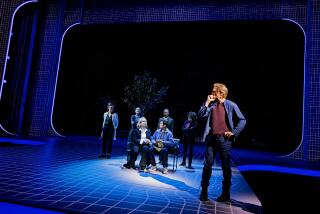Life’s a Campus, and a River Runs Through It
- Share via
Recently I was on the campus of my alma mater, UC Irvine, as a guest of Thomas Keneally and his students in the writing program there. I was somewhat flattered that Tom liked my work enough to believe I might have something to offer his young writers, though the idea crossed my mind that an enthusiastic conversation we had recently about rugby might have paved the way for my invite. Mr. Keneally is a sports fan, as am I, and you know how it is when two closet jocks get together.
I looked forward to the day of the campus visit. For one thing, I was curious about the MFA Program in Writing, considered by many to be the second best in the nation (behind the one at the University of Iowa). I wondered how this successful program operated, how the workshops were conducted, what kind of students it attracted and how it shaped them. I was also happy to be rubbing elbows with college-age people, because I rarely get a chance to do that anymore--haven’t, in fact, since I was an undergraduate at UCI back in 1974-76.
Moreover, I anticipated a visit to my old Humanities Office Building haunts, the classrooms and lecture halls, the concrete and grass that is the campus. It is always interesting--and sometimes much more than just that--to go back to a place that meant something to you once.
It was one of those spring afternoons too cool for just a shirt and too warm for anything else. I found my way to the Humanities parking lot and, all my quarters dutifully loaded into the meter, went to find Mr. Keneally and his waiting prodigies.
Few places on Earth strive for an air of permanence more energetically than a school of higher learning, yet manage to achieve just the opposite effect. Yes, the buildings of the humanities complex were exactly the same as they were 20 years ago. The landscaping hadn’t changed much, if any (as a former member of the UCI landscape maintenance crew, I can vouch semi-professionally for this). The hallways and floors had the same dull industrial patina they always did. Everything smelled the same. I imagine that a great many of the tenured teachers there when I was an undergraduate are still there now.
But, in my mind at least, a college is primarily a channel, and the students who fill it are the river. Now, at first glance, the students looked pretty much like they did two decades ago. The ethnic ratios may have changed, but the sweat shirts and backpacks, the shorts and sandals, the odd air of camaraderie and preoccupation would have been recognizable almost any place in the world: studentleben.
But once you dismiss the generalities of appearance and consider the content of the campus population, it comes as a minor shock to realize that not one of these people was here a few years ago--let alone 20 years ago--and, with only a fractional exception, will not be here much past the middle of the decade. As I blended with the students on the spacious walkways of the campus, I had the feeling I was joining a river that was, quite literally, just passing through. This is not a bad feeling, but it contradicts the passing scenery--the comforting stasis of the physical, the institutional dependability of place.
I don’t remember feeling this way when I attended school here, because I was part of the river, being swept along predictable banks and was--like a lot of young people--too self-absorbed to notice or care that I was just a drop of water, rushing by, soon to be gone. What I do remember is lying on the grass in Aldrich Park during a searing Santa Ana wind, my brain and body crawling with premonitions of life and death, love and work, and the mysterious power of the English language I was studying.
Today I was no longer the river; I was part of the bank.
Mr. Keneally’s students were young, bright and pleasant. Todd is writing a novel about a group of friends growing up in Santa Barbara. It has shades of Fitzgerald and, as Keneally pointed out, “legs”--meaning that the tone of the prose bears enough weight and promise to carry the writer (and reader) through an entire book. Todd’s classmates had enough perspicacity to guide him along what I thought would be the proper path for the novel, so I said little.
Hector is writing a novel about Guatemalan refugees living in Los Angeles but still locked within the turmoil of their homeland. His narrative was succinct, very nicely observed and had the kind of protagonist/antagonist dramatic line that people love to read. I didn’t have much to offer that his peers did not.
Watching Keneally conduct a workshop is quite enjoyable. For those who need an introduction, he is certainly best known as the author of “Schindler’s List,” though his achievements in writing and life are much broader than one book. Those who have spent time with him know him as a superb raconteur, a genially outspoken social animal and a man very much engaged with the world around him.
All of these qualities seem to work for Keneally--and for his students--in the workshop. He made comments, to be sure, comments born of critical sympathy for a young writer’s difficult task. Good criticism is important.
But more importantly he told stories to make his points. Keneally understands what all novelists must either develop or be born with: that the novelist’s first order of business is to tell a convincing story with convincing characters.
So, by way of demonstration, Keneally simply does it. At one point he launched into a long and highly detailed account of the vengeance one man took against another, and by the time he was finished it was clear that Keneally had prescribed with a circuitous exactness what Hector needed to do with one aspect of his book. Then he was off on another story, then another. It seemed to me that Keneally was giving one of the best lessons an experienced writer could offer a young, inexperienced one: Life is stories.
After class I went to the truck and found a parking ticket on the windshield. It was only then that I remembered how talented those campus police are, how, 20 years ago, your car just seemed to sprout those things the second the meter clicked off. Another part of the bank, I thought, another nod to the illusion of permanence in this great institutional river. It flapped off the window and onto the road as I headed home.


